Changes to APLS Guidelines PowerPoint PPT Presentation
1 / 24
Title: Changes to APLS Guidelines
1
Changes to APLS Guidelines
- SpR Training Day
- 24th February 2006
2
Changes?
- Published by UK Resuscitation Council in December
2005 - Implemented by QMC February 2005
- Not yet incorporated into ALSG courses
3
DONT PANIC!
- The updated treatment recommendations in
Guidelines 2005 do not define the only way that
resuscitation should be achieved, they merely
represent a widely accepted view of how
resuscitation can be undertaken both safely and
effectively. - The publication of new treatment recommendations
does not imply that current clinical care is
either unsafe or ineffective.
4
Changing Behaviour
Long term change
5
Objectives
- Why change?
- Paediatric BLS
- Paediatric ALS
- Questions
6
Why Change?
- New scientific evidence
- Simplification
- Consistency
7
Paediatric BLS
- Compressionventilation ratios
- Age definitions
- Foreign body airway obstruction sequence
8
Bystander Resus
9
Duty to Respond Paediatric BLS
10
FBAO
11
Paediatric ALS
- IV or IO (rather than into trachea)
- Either cuffed or uncuffed tubes
- One shock not three - 4J/KG
- Adrenaline dose 10mcg/kg
- AEDs
- Other Drugs
- Temperature Control
- Parental Presence
12
(No Transcript)
13
Paediatric ALS
- Shock energy level 4J/Kg
- Biphasic as effective as monophasic and less
post-shock myocardial dysfunction - No difference between 2-4J/Kg
- Adrenaline 10mcg/kg
- Vasoconstricts, improves CPP, improved
contractility, stimulates spont. contraction,
more intense VF - No evidence of improved outcome with high dose
and maybe worse outcome
14
AEDs
- Standard AED can be used in children over 8yrs
- Purpose made pads/programs for children 1-8 yrs
- IF NOT AVAILABLE
- Unmodified adult AED gt 1yr old
- Insufficient evidence for lt 1yr old
15
Paediatric ALS
- Several studies show no greater risk from cuffed
tubes - Correct size, position and inflation pressure
- May be preferable in some circumstances
- Shock sequence
- High success rate from 1st shock
- Less interruption of CPR
16
Paediatric ALS
- Amiodarone
- Membrane stabilising drug
- Increases duration of action potential and
refractory period - Slows AV conduction
- Mild negative inotrope
- Peripheral vasodilatation
- 5mg/kg diluted in D5
- Large/central vein
17
Paediatric ALS
- Atropine
- For bradycardia unresponsive to ventilation and
circulatory support - 20mcg/kg (max 600mcg min 100mcg)
- Magnesium
- Arrythmia due to hypomagnesaemia or polymorphic
VT torsade de pointes - MgSO4 ivi 25-50mcg/kg (max 2g) over several
minutes
18
Paediatric ALS
- Calcium
- may have detrimental effects on ischameic
myocardium and impair cerebral recovery - thus only if indicated
- Hypocalcaemia
- Hyperkalaemia
- Ca channel blocker OD
- Dose 0.2mls/kg of 10 Calcium chloride
- Slow IV if spontaneous circulation
- Fast IV push if arrest
19
Paediatric ALS
- Sodium Bicarbonate
- Arrest leads to mixed acidosis
- Giving bicarb generates CO2
- Exacerbates intracellular acidosis
- Produces a negative inotropic effect on ischaemic
myocardium - Large osmotically active sodium load to already
compromised circulation and brain - Left shift in oxygen dissociation curve
inhibiting release of oxygen to tissues - Prolonged arrest, hyperkalaemia and TCA overdose
- 1-2ml/kg of 8.4 solution
20
Paediatric ALS
- Temperature
- Mild hypothermia suppresses many of chemical
reactions associated with reperfusion injury - Some evidence of benefit from adults
- If core temp lt37.5C DO NOT rewarm
- If lt33C rewarm to 34C
- If temp gt37.5 then cool
- Prevent shivering by sedation/nm blockade
21
Paediatric ALS
- Studies show benefits for families who are
present at resus - Dedicated staff member
- If impeding then alternative arrangements
- Team leader decides when to stop
- Team debrief
22
Summary
- Changes are in response to new evidence and drive
for simplification - Dont delay start of compressions and emphasis on
continuous CPR - Changes to timing/doses of adrenaline and shocks
23
BUT
- Some CPR is always better than NO CPR
- If you cant remember the new way do it the old
way
24
Questions?

